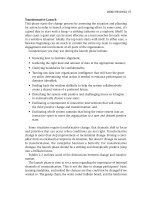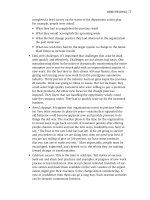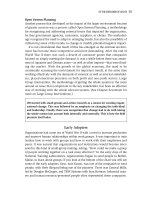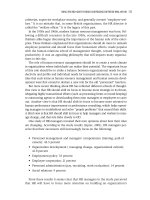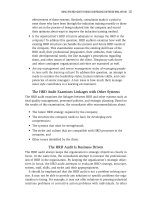Practicing Organization Development (A guide for Consultants) - Part 3 pptx
Bạn đang xem bản rút gọn của tài liệu. Xem và tải ngay bản đầy đủ của tài liệu tại đây (195.99 KB, 10 trang )
xix
∂
∂
PRACTICING ORGANIZATION
CHANGE AND DEVELOPMENT
SERIES BOARD STATEMENT
O
n behalf of the advisory board, I am pleased to be a part of and to support
the (re)launching of the Practicing Organization Change and Development
Series. The series editors, the publishers, and the advisory board vigor-
ously discussed and debated the series’ purpose, positioning, and delivery. We
challenged extant assumptions about the field of organization change, change
management, and organization development; we argued about perspectives on
relevance, theory, and practice; and we agreed that there’s a story that needs to
be told through a series of books about change. In this first board statement, I
want to relate—as best I can—our rationale for re-naming the series, describe
our purpose, and position this book in the series.
The most obvious change in this re-launching is the series title. We argued
and agreed that it should be changed from “Practicing Organization Develop-
ment: The Change Agent Series for Groups and Organizations” to the “Practic-
ing Organization Change and Development Series.” While that may be the most
obvious change, it is certainly not the most significant one. Our discussion and
debates led us to the firm belief that organization development (OD) was only
03_962384 flast.qxd 2/3/05 12:15 AM Page xix
one method of organization change, that OD was misunderstood by many to
be synonymous with organization change and change management, that OD’s
reputation is at best fragmented, that the field could not be defined by tools and
techniques but had to embrace the entirety of the social and behavioral sciences,
and that the series we wanted to be the advisory board for should be of the
highest quality in terms of both theory and practice. Ultimately, we agreed that
the books in this series should redefine the field of organization change and
development in the broadest sense and should describe the best of innovative
approaches to organization change and development.
A good example of our intent to redefine the field is to compare and contrast
OD and change management. While both are concerned with change, the labels
do describe their intent and philosophy. Organization development is concerned
with development, growth, learning, and effectiveness. It is based primarily in
the behavioral sciences. Change management, on the other hand, is concerned
with implementation, control, performance, and efficiency. It is borne out of re-
engineering and project management perspectives. Our view was that organi-
zation leaders would be best served by a series that embraced and integrated a
variety of views on change. “Good” change in a global economy cannot be
defined only by amounts and levels of participation, by costs (or people)
reduced or profits achieved, or increases in organization size.
The first book in the series re-launching, Practicing Organization Development,
is a good example of this purpose. It represents an initial step to define one
boundary of the field of organization change and development. Written from the
OD perspective, it proposes that good change is more often participatory than
dictated, more concerned with learning and growth than performance, and more
dependent on the behavioral sciences than economics. To be sure, the field of
organization change and development is broader than the perspective described
here. However, this first installment in the series does represent a practical, state-
of-the-art description of the OD perspective.
In addition to redefining the field, we believed that the series should be written
for and by practitioners interested in facilitating effective organizational change.
Books should be grounded but not constrained by theory and practice and geared
to providing advice on the practical issues and applications facing organizations
and their leaders. Again, Practicing Organization Development reflects our
intended purpose. It is written by some of the best scholar-practitioners in the
field. The authors have the standing to describe best practice authoritatively.
Finally, the chapters in this book are grounded in both theory and practice.
Our hope is that this series will raise the level of debate about organization
change and development and that it will be of great assistance to change prac-
titioners and organization leaders entrusted with growth, development, and per-
formance of organizations. We hope you agree that this book is a good start.
—Christopher G. Worley
XX BOARD STATEMENT
03_962384 flast.qxd 2/3/05 12:15 AM Page xx
Series Editors
Kristine Quade
Roland L. Sullivan
William J. Rothwell
Advisory Board
Ed Schein, Series Consultant
David L. Bradford
W. Warner Burke
Lenneal Henderson
Edith Whitfield Seashore
Christopher G. Worley
BOARD STATEMENT XXI
03_962384 flast.qxd 2/3/05 12:15 AM Page xxi
03_962384 flast.qxd 2/3/05 12:15 AM Page xxii
xxiii
∂
∂
FOREWORD
OD: A PROMISE YET TO BE REALIZED
Building on a sound research base from the behavioral sciences, OD started in
the 1960s with great promise. From the early Hawthorne studies and then
expanded by the work of Argyris, French, McGregor, Likert, Marrow, Maslow,
and others, OD appeared to open up an entirely new way to produce change
and to manage organizations. Research in the laboratory and the field suggested
that:
• Expertise is not just held by the experts, but exists throughout the orga-
nization—especially by those who are closest to the problem.
• “Resistance to change” doesn’t have to be a given. When people are
involved in the change process, not only does cooperation increase, but
the quality of the outcome dramatically improves.
• It is possible to not only solve the problem at hand, but the very process
of dealing with difficult, even contentious issues can significantly
increase individual, team, and organizational ability to function more
effectively. That is the development in OD.
Organizations ranging from such major corporations as Esso, TRW, Alcan,
P&G, and General Foods to religious organizations (such as the Episcopal
03_962384 flast.qxd 2/3/05 12:15 AM Page xxiii
Church) and the U.S. Army eagerly embraced organization development to help
them cope with the increasing demands of change. The OD Network was formed
and quickly grew in size. Consultants would gather to share what they had learned
and build on the experiences of others. From all of this a variety of new approaches
were developed that involved meaningful participation of all levels throughout the
organization, and not just those at the top. Internal OD consultants held positions
high in the organization, often reporting to the most senior executives.
A series of core learnings emerged from this growing field:
• Action research as a change strategy. Kurt Lewin had observed, “The
best way to understand an organization is to try to change it.” This led
to the approach of collecting data after each intervention as a basis for
further redesign.
• A systems approach where one had to look as much, if not more, at the
connections between the parts as to the parts themselves. For a while,
socio-technical systems thinking played an important role in helping inte-
grate work processes with human needs.
•“The client knows best.” Rather than the external expert arriving with
the answer to lay on the organization, it would now be a joint endeavor.
OD consultants saw that one of their key tasks was to assist the client in
discovering what solution was best.
• The emphasis on processes and not just on outcomes. Focusing on
improving the organizational processes would increase the probability of
a successful solution.
• Working at multiple levels of analysis. There might be training needed
for individuals to support change, team building, working on inter-
group collaboration, and so forth. While there was less emphasis on
structure, attention was paid to issues of culture. It was understood that
working at only one level of analysis was insufficient.
• The importance of values not just in the organization, but the values
held by change agents in terms of how individuals are to be treated.
These were heady days in the late 1960s and 1970s, and even into the 1980s.
There appeared to be numerous success stories, OD went international, and The
OD Institute was established and set up a process of certification for consultants.
But those heady days appear to have passed. Even though the number of
people who call themselves “OD consultants” has continued to increase, they
are rarely in the top layers of organizations. Instead, if they exist at all within
the institution, they are relegated far down in the bowels of the organization,
usually being part of HR (not the highest status area itself). CEOs rarely call in
OD consultants and instead rely on the major consulting firms, many of which
XXIV FOREWORD
03_962384 flast.qxd 2/3/05 12:15 AM Page xxiv
have taken on the rhetoric (if not the practice) of the OD field. OD consultants
may be brought in, but usually for small ventures—a team-building activity, a
“visioning” experience at some retreat, perhaps some personal coaching, but
rarely the system-wide interventions that occurred before.
What is perplexing about this diminution in role and status is that one would
have expected an increase in importance of OD, given the forces facing organi-
zations today. Change is occurring at an even faster pace than three decades
ago, so the ability to productively manage change is a key leadership concern.
Why with so many mergers and acquisitions, changes in technology (including
the central role that IT now plays), globalization with new markets and new
competitors—all of which require new ways for individuals, departments, and
divisions to operate and relate to each other—don’t all leaders have an OD con-
sultant by their side? Also, as more and more organizations are moving into the
“knowledge economy,” why aren’t OD professionals, who are expert on
approaches that release the expertise throughout the organization, heavily
involved in the central workings of most organizations?
These questions are troubling many in the OD field. The OD Network, in col-
laboration with The OD Institute, has launched a study to examine the present
state of OD and where it should be going. The December 2004 issue of The Jour-
nal of Applied Behavioral Science is devoted to this question. And we (myself
and Warner Burke) will publish a book in the Pfeiffer Practicing OCD Series that
asks the leaders in the field to comment on this dilemma.
While no final conclusions can be drawn at this time, I think there are four
major factors that play a part in the decreased centrality of OD:
1. Few of those who call themselves OD consultants are really doing OD! I
am defining OD as “planned change that takes a systems approach and
makes extensive use of collaborative techniques to both solve the
immediate problem and leave the organization in a more competent
state to handle future challenges.” What is interesting is that there is
no agreed-on definition of OD, which says something about the scat-
tered nature of the field!
Most people who label themselves as OD consultants may use various
techniques and approaches that the field has developed, but that is not
the same thing as a comprehensive systems approach to planned
change. Doing some team building here, some coaching there, and
training over in that area is not OD. These approaches can be useful in
solving an immediate dilemma, but it is unlikely that alone they can
produce sustained improvement in how the organization functions. OD
has been accused of being faddish in grabbing on to the latest tech-
nique. Such approaches can be useful as means to an end, but they
should not be an end in and of themselves.
FOREWORD XXV
03_962384 flast.qxd 2/3/05 12:15 AM Page xxv
2. Where is the O in OD? This was a question that Richard Beckhard
repeatedly raised. If the key goal is to make the organization more
effective, that has to be the primary focus of any intervention. Improv-
ing individual competency or team performance is a laudable objec-
tive, but that is unlikely to translate to organizational improvement.
Likewise, if one wants to improve the organization as an entity, then it
is important to also consider other core organizational functions.
Unfortunately, socio-technical systems thinking has largely disap-
peared. Yet OD has to be concerned and work with the impact of other
processes, such as the introduction of new information systems or
ways to make re-engineering both effective and humane. But most OD
consultants tend to ignore these areas.
3. There is no integrative theory of change. OD has some models of
change, but these tend to describe change as a series of steps or stages.
An integrative theory of change would speak to such issues as When
should one collaborate and when should change be imposed? What are
the various ways to build alliances and with whom? What stakeholders
are crucial and which can be ignored? How should internal politics be
handled? And even, When should one use political strategies? Change is
a multi-dimensional process and OD has been charged with being
politically naïve. There is a time for openness and transparency and a
time when that won’t work. That is the world in which organizational
leaders live, and if OD is to be listened to and is to be effective, it
needs a sophisticated, integrated theory of change.
4. OD is confused about its values. On the one hand, OD claims that it is
firmly based in the applied behavioral sciences. But on the other hand,
it stresses its humanistic roots. What happens when the latter is not
supported by the former? Unfortunately for many OD consultants, it is
the humanistic values, not the applied behavioral sciences, that domi-
nate. (A senior consultant in the field commented that “Imposed
change never works,” which denies so much historical reality.) What
OD has lost is its commitment to rigorous, objective analysis of what
truly is effective and instead has replaced that with a view of what it
thinks the world should be.
OD is potentially too important to forego the impact it should have. Fortu-
nately, this book comes at a very propitious time in the field’s history. The edi-
tors have assembled a wide range of views. I would urge the reader to drink
deeply from these many sources. But you will benefit most if you see these
chapters as separate pieces of an unassembled mosaic that need your help to
XXVI FOREWORD
03_962384 flast.qxd 2/3/05 12:15 AM Page xxvi
join them into an integrative whole. What theory of change must you build to
produce a systemic approach to planned change that truly leaves the organiza-
tion much more developed to face future problems? If you have done that, then
organizational leaders are more likely to seek your counsel.
David L. Bradford, Ph.D.
Graduate School of Business
Stanford University
Palo Alto, California
September 2004
FOREWORD XXVII
03_962384 flast.qxd 2/3/05 12:15 AM Page xxvii
03_962384 flast.qxd 2/3/05 12:15 AM Page xxviii





